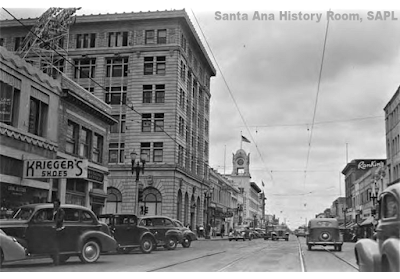 |
| The Dairy Bar in Tomorrowland, 1957 (Courtesy Dave DeCaro, Davelandweb.com) |
Q: Which Disneyland attraction was the biggest flop?
A: The short-lived, twenty-million-dollar Light Magic parade (1997), with step-dancing, child-frightening pixies is a contender for this. But does a parade count as an attraction?
Some of the worst attractions were the “filler” stuffed into the still-incomplete Tomorrowland during the first few years Disneyland was open. At least the Color Gallery, sponsored by Dutch Boy Paint, let kids mix and match colors and kept its doors open into the early 1960s.
But the Dairy Bar, sponsored by the American Dairy Association, was a (milk) dud which disappeared in less than three years. It featured static models of futuristic cows watching color TVs and of milkmen making deliveries in helicopter jetpacks. At the spine-tingling conclusion, guests received a glass of milk. Lactose-intolerant guests undoubtedly appreciated the Bathroom of Tomorrow exhibit next door.
You can read much more about the Dairy Bar and view lots of photos on my pal Dave DeCaro's wonderful Daveland website.
Q:. What else, other than "it's a small world," came to Anaheim from the 1964 New York World's Fair?
A: Disney ended up adopting numerous attractions they'd developed for the Fair, including Great Moments with Mr. Lincoln, from the Illinois Pavilion; General Electric's Carousel of Progress; and animatronic dinosaurs from Ford's Magic Skyway.
The Dancing Waters, a German water and light show, operated like a pipe organ, was featured at the Fair and was a fixture at the Disneyland Hotel from 1970 into the 2000s.
Another European import to the Fair, The Wide World In Wax, spent 1966 and 1967 at 1850 S. Harbor Blvd. Its columned facade now graces the Hotel Lulu. The museum featured "religious, fictional and historical scenes with over 100 wax figures." Their figure of Moses looked exactly like his driver's license photo.
Q: What’s the strangest-ever Disneyland attraction?
A: There have been some pips, from the aforementioned Bathroom of Tomorrow to a cow with Mickey Mouse-shaped spots. But it’s hard to top the high weirdness of The Wizard of Bras.
When Disneyland opened, the Hollywood-Maxwell Brassiere Co. had an Intimate Apparel Shop on Main Street. In addition to racks of unmentionables, the store had a show. The Wizard of Bras -- a talking figure that predated “audio animatronics” -- served as MC for an 1890s fashion show. As the show’s revolving stage turned, “3D” images of models did a nap-inducing strip tease, from turn-of-the-century outerwear to just corsets and pantaloons. The shop closed six months after opening. The storefront, with a porch and a couple chairs out front, can still be found on the east side of Main Street.
See photos and read more about the Wizard it at my friend Werner Weiss' wonderful Yesterland website.
Q: Where does the slang term "E ticket" come from?
A: Orange Countians of a certain age will remember when Disneyland, rather than including all attractions with general admission, sold ticket books. From 1959 until ticket books were completely phased out in 1982, the most popular attractions required an "E ticket." The least popular were A tickets. B, C, and D ticket attractions fell between. Internally at least, Disney still refers to their snazziest rides as "E tickets." Today, this O.C.-born phrase is used nationwide to describe any major adrenaline-producing experience. Examples of real-life E ticket experiences include skating down slopes of Laguna's Third Street, bodysurfing at the Wedge, and making the steep ascent out of John Wayne Airport.





